
Dawes is a lunar impact crater located in the wide straight between Mare Serenitatis and Mare Tranquilitatis. To its southwest lies the larger crater Plinius, and to its northeast sits the Mons Argaeus mountain rise. It is named after British astronomer William Rutter Dawes.
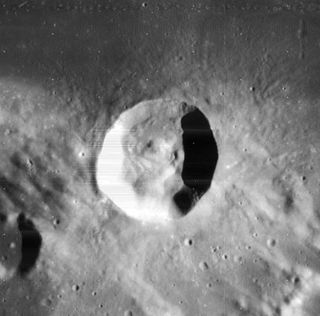
Menelaus is a young lunar impact crater located on the southern shore of Mare Serenitatis near the eastern end of the Montes Hæmus mountain range. Its diameter is 27 km. To the southwest is the small crater Auwers, and to the west-southwest is the even smaller Daubrée. To the northeast is a faint rille system named the Rimae Menelaus.
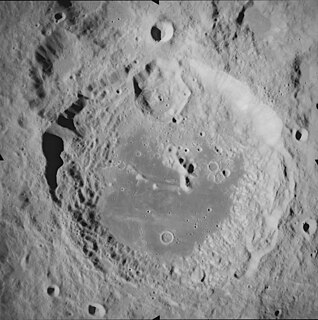
Aitken is a large lunar impact crater that lies on the far side of the Moon, named for Robert Grant Aitken, an American astronomer specializing in binary stellar systems. It is located to the southeast of the crater Heaviside, and north of the unusual formation Van de Graaff. Attached to the southwest rim is Vertregt. To the southeast is the smaller Bergstrand.
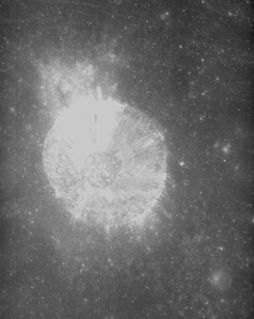
Cauchy is a small lunar impact crater on the eastern Mare Tranquillitatis. It was named after French mathematician Augustin-Louis Cauchy. It is circular and symmetric, with a small interior floor at the midpoint of the sloping inner walls. Due to the high albedo of this bowl-shaped formation, it is particularly prominent at full Moon.

Clerke is a tiny lunar impact crater named after Irish astronomer Agnes Mary Clerke, who played a role in bringing astronomy and astrophysics to the public in Victorian England. It is located near the eastern edge of Mare Serenitatis in the midst of a rille system named the Rimae Littrow after the crater Littrow to the east. It is roughly circular and cup-shaped, with a relatively high albedo. In a valley to the southeast is the landing site of the Apollo 17 mission. Clerke was previously designated Littrow B.

Picard is a lunar impact crater that lies in Mare Crisium. The crater is named for 17th century French astronomer and geodesist Jean Picard. It is the biggest non-flooded crater of this mare, being slightly larger than Peirce to the north-northwest. To the west is the almost completely flooded crater Yerkes. To east of Picard is the tiny Curtis.
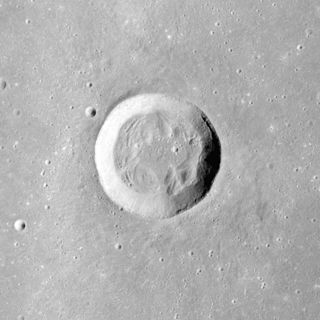
Bessel is a small lunar impact crater that is located in the southern half of the Mare Serenitatis. The crater was named after the German astronomer Friedrich Wilhelm Bessel in 1935. Despite its small size, this is the largest crater to lie entirely within the mare. It lies to the north-northeast of the crater Menelaus.

Diophantus is a lunar impact crater that lies in the southwestern part of the Mare Imbrium. It was named after ancient Greek mathematician Diophantus. It forms a pair with the larger crater Delisle to the north. Diophantus has a wide inner wall and a low central rise. To the north of Diophantus is the sinuous rille designated Rima Diophantus, named after the crater. Diophantus C lies near the exterior of the southwest wall.

King is a prominent lunar impact crater that is located on the far side of the Moon, and can not be viewed directly from Earth. The crater was named after Arthur Scott King and Edward Skinner King in 1970. Prior to that, this crater was known as Crater 211. It forms a pair with Ibn Firnas, which is only slightly larger and is attached to the northeast rim of King. To the northwest is the crater Lobachevskiy, and Guyot is located an equal distance to the north-northwest.
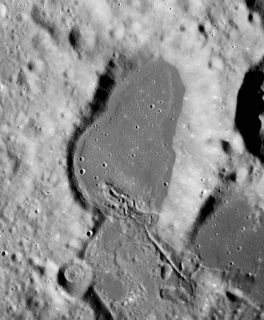
Bowditch is a lunar impact crater that lies on the far side of the Moon, just beyond the eastern limb. It is located on a region of the lunar surface that is brought into view due to libration, but at such times the area is viewed from the edge and so not much detail can be observed. It lies just to the north of the small Lacus Solitudinis lunar mare, between the craters Titius to the southwest and Perel'man to the east-northeast.

Brunner is a lunar impact crater that is located along the eastern limb of the Moon, to the southeast of the Mare Smythii. At this location the crater is viewed from the edge, and so it is not possible to see much detail from the Earth. The visibility of this formation is also affected by libration. The crater lies to the southwest of the walled plain Hirayama, and to the east of the elongated crater Houtermans.

Condorcet is a lunar impact crater that is located in the eastern part of the Moon's near side, to the southeast of the Mare Crisium. It was named after French mathematician Marquis de Condorcet. To the northeast of Condorcet are the craters Hansen and Alhazen.

Mons Hadley is a massif in the northern portion of the Montes Apenninus, a range in the northern hemisphere of the Moon. It has a height of 4.5 km (2.8 mi) 14,764 ft (4,500 m) above the adjacent plain and a maximum diameter of 25 km at the base.

Ibn Firnas is a lunar impact crater on the far side of the Moon. In 1976 it was named after Abbas Ibn Firnas, a polymath from Andalucia who, in the 9th century, devised a chain of rings that could be used to simulate the motions of the planets and stars.
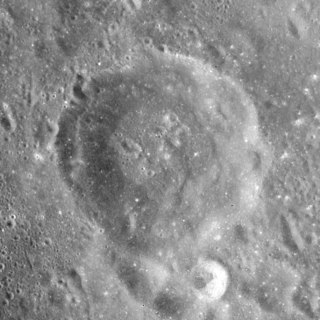
Ganskiy is a lunar impact crater that is located on the far side of the Moon. It lies to the southeast of the walled plain Hirayama.

Hume is a small lunar impact crater that lies along the eastern limb of the Moon, along the southeast edge of Mare Smythii. It is located just on the far side of the Moon, but it is often brought into sight from Earth due to libration. Hume lies just to the west-northwest of the much larger Hirayama, and to the northeast of the flooded crater Swasey.

Hirayama is a large lunar impact crater that is located on the far side of the Moon, just beyond the eastern limb. This region of the surface is sometimes brought into view from Earth during periods of favourable libration. However it is best viewed from orbit. This crater is located along the southeastern edge of the Mare Smythii, to the northeast of the crater Brunner. To the northeast of Hirayama is Wyld. On the west rim of Hirayama is the small, bright-rayed crater Bandfield.

Planté is a lunar crater that is situated near the eastern inner wall of the much larger crater Keeler. Just to the east, attached to the exterior of Keeler, is the large crater Heaviside. Planté is located on the far side of the Moon and cannot be viewed directly from the Earth.

Ludwig is a small lunar impact crater that is located just beyond the eastern limb of the Moon, placing it on the far side from the Earth. It lies just to the east of the much larger crater Hirayama, and to the north of Ganskiy.

Mons Moro is a mountain on the near side of the Moon, within Mare Cognitum, and southwest of the crater Bonpland. The name of the feature was approved by the IAU in 1976, and refers to Italian geologist Anton Lazzaro Moro.






















